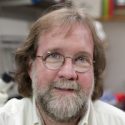New director takes over at Primate Center
It is not likely, by a long shot, to be his biggest challenge, but reorienting his collegiate athletic allegiances and keeping peace in the family will be one pressing priority for neurophysiologist Jon Levine, the Northwestern University researcher who takes the reins of the Wisconsin National Primate Research Center (WNPRC) this month.

Levine
For Levine, who has been a professor of neurobiology and physiology at Northwestern since 1984, adjusting to Wisconsin will require more than donning cardinal and white on football Saturdays. He assumes leadership of a center that is one of the most intellectually stimulating and scientifically important on campus and, at the same time, one of the most controversial due to its mission of research involving nonhuman primates.
And while Levine has conducted studies with primate models, including collaborations with UW–Madison researchers, he has performed the bulk of his research using rodent models. “I see it as a great advantage to have experience in both research worlds,” explains Levine, who gained his first experiences with monkeys as a postdoctoral fellow at the Oregon National Primate Research Center in 1982. “The great majority of current research and proportionally ‘hot’ areas of progress are rodent based. That I can walk easily in both worlds gives me a broader perspective and broader knowledge base from which to operate.”
Levine assumed his new post Sept. 1. The Wisconsin National Primate Research Center is one of eight federally supported primate research centers and the only one in the Midwest. The center has a staff of about 200 and is used to varying degrees by as many as 250 researchers from UW–Madison and other institutions.
“Jon Levine is an excellent addition to our faculty and I have no doubt he’ll be a great leader for one of our most critical research centers,” says Martin Cadwallader, dean of the UW–Madison Graduate School. “He brings a vision, a history of accomplishment, and the kind of positive energy required to lead such a dynamic and important organization. I would also like to thank Donna Paulnock, who is stepping down as interim director, for her exceptional leadership over the past few months.”
While the center, which has a colony of about 1,400 primates representing three species, mostly rhesus macaques, is a lightning rod for controversy about the nature of its work, it is unarguably a dynamic, front-line research center with top-flight programs of research on such things as HIV vaccine development, regenerative medicine and reproduction, and aging and metabolic disease. In the 1990s, the first nonhuman primate embryonic stem cells were derived there in two species of monkeys before the first human embryonic stem cells were successfully cultured in 1998 by James Thomson, then a staff scientist at the center.
“As Midwestern, Big Ten schools, Wisconsin and Northwestern are similar in many ways but differ significantly in terms of their scientific communities,” Levine observes. “Wisconsin’s academic and research units are more numerous, bigger in size and range across many more disciplines. The breadth and high quality of science across the University of Wisconsin–Madison is staggering.”
From Levine’s perspective, some of the most exciting prospective developments in human health will be a part of the center’s research portfolio, thanks to how it has been positioned scientifically. Regenerative medicine, for example, the ability to replace diseased or damaged cells or tissue, will require the use of nonhuman primate models to advance. “Real scientific progress is being made in bionanotechnology, especially in the development of methods to engineer tissues and cells for transplantation and regenerative medical therapies. Effectively curing diseases such as type 1 diabetes mellitus with new biotechnological advances is no longer a pipe dream. The road to translation from rodents to humans could run right through the Primate Center.”
A priority for the center, says Levine, is to optimize a rare resource: “Nonhuman primate studies provide avenues to study human disorders in ways that mice and rats do not. The challenge faced by all the National Primate Research Centers is to utilize the unique strengths of this precious animal resource in the newest, strongest and most important research projects.”
To help accomplish this, Levine envisions forming integrated and cohesive scientific divisions within the center to provide the “functional scaffolding” for generating the best new science, amplifying resources and evaluating progress. Organizing in such a way, Levine argues, will significantly aid in the establishment of collaborations with researchers from Wisconsin and other institutions.
Another goal Levine has set for himself and the center is to work with the Research Animal Resource Center and other relevant entities to develop a book — literal and figurative — that maintains the gold standard for all policies and practices that relate to the use of nonhuman primates in research. “It will be a living document that will undergo constant updating and embellishment, according to new developments in veterinary practice, behavioral science, primatology and biomedical research.”
In addition to addressing the organizational and scientific challenges of the Primate Center, Levine is acutely aware of the need for open and honest communication with the public and the Madison community, in particular. While he has no illusions about his ability to sway the most adamant critics of nonhuman primate research, he argues that there are many untold truths, chief among them that center staff are committed, hard working people dedicated to helping solve some of the most pressing biomedical issues of our day.
Tags: animal research, research



